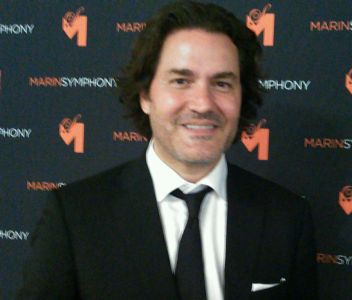|
Chamber
JASPER'S LUSH PERFORMANCES OF STILL, DVORAK AND FUNG QUARTETS
by Abby Wasserman
Sunday, November 10, 2024
Symphony
A SHOUT AND SONIC WARHORSES AT NOVEMBER'S SRS CONCERT
by Peter Lert
Saturday, November 9, 2024
Choral and Vocal
ECLECTIC WORKS IN CANTIAMO SONOMA'S SEASON OPENING CONCERT
by Pamela Hicks Gailey
Sunday, October 27, 2024
Symphony
FRANKENSTEIN THRILLS IN UNIQUE SO CO PHIL CONCERT IN JACKSON THEATER
by Peter Lert
Saturday, October 26, 2024
Choral and Vocal
BAROQUE EXTRAVAGANZA AT AMERICAN BACH MARIN CONCERT
by Abby Wasserman
Friday, October 25, 2024
Recital
LARGE AUDIENCE HEARS AX IN WEILL PIANO RECITAL
by Terry McNeill
Thursday, October 24, 2024
Symphony
SRS' NEW SEASON OPENS WITH BEETHOVEN AND COPLAND IN WEILL
by Terry McNeill
Saturday, October 19, 2024
Chamber
TWO CHAMBER MUSIC WORKS AT MARIN'S MT. TAM CHURCH
by Abby Wasserman
Sunday, October 13, 2024
CALLISTO'S ELEGANCE IN UPBEAT 222 GALLERY CONCERT
by Terry McNeill
Friday, October 11, 2024
Chamber
FINAL ALEXANDER SQ CONCERT AT MUSIC AT OAKMONT
by Terry McNeill
Thursday, October 10, 2024
|
 |
 Cellst Zuill Bailey May 1 At Marin Symphony Concert (AW Photo) |
SONIC SPLENDOR AT MARIN SYMPHONY SEASON FINALE
by Abby Wasserman
Tuesday, May 1, 2018
The Marin Symphony Orchestra ended the current season with a flourish, interpreting big and small works by Richard Strauss and Stravinsky. Strauss and Stravinsky were contemporaries for 40 years, but inhabited different worlds. Both composers were affected by cataclysmic changes and war, and musically, as conductor Alasdair Neale pointed out in a brief introduction to the program, they had in common a mastery of orchestral colors and the ability to tell a story.
Strauss’s one-movement Serenade for Wind Instruments in E-flat Major opened the program. Scored for thirteen players, the standard double winds plus four horns and contrabassoon, it is in sonata form and has the feel of Strauss’s hero Mozart. It was composed when Strauss was only 17, and was his first major success as a composer. Chorale-like harmonies and lyrical solos by each instrument in turn had the ease and comfort of long intimacy. The piece conjured a verdant countryside and changing skies. Despite a brief juncture when the ensemble seemed to waver, it was a charming introduction to the youthful Strauss and set the stage for a tone poem from his maturity, Don Quixote (Fantastic Variations on a Theme of Knightly Character, Op. 35), featuring cellist Zuill Bailey as the misguided Don who is sure that what he sees is real, when nearly always it is not.
Based on picturesque incidents in the Cervantes novel, Strauss’s 40-minute vivid soundscape makes full use of the symphony orchestra’s colors. Written the same year as tone poem The Hero’s Life and closely followed by Thus Spake Zarathustra, this is Strauss at his most powerful. Mr. Bailey is a nuanced performer and riveting to watch. His cello playing had gorgeous duets with concertmaster Jeremy Constant’s violin (the youthful spirit of Don Quixote) and with violist Jenny Douglass as Sancho Panza. Tubist Zachariah Spellman underscored Sancho Panza’s common sense and genuine warmth. Through the medium of his amber-hued cello, Mr. Bailey gave life to the Don. And within the orchestral soundscape, beautifully shaped by Mr. Neale, all the characters were clearly heard: the trotting of Don Quixote’s horse, Rocinante; the herd of sheep that Quixote believes are an army; the windmills he is certain are evil giants.
The orchestra played well and there was palpable camaraderie among the players, conductor, and soloist. Each emotion so eloquently formed in Mr. Bailey’s cello lines were elegant, and near the end, when the music suggests the demise of the elderly knight, Mr. Bailey remained motionless until the conductor lowered his baton. The audience rose with an ovation, and the soloist, presented with a bouquet, graciously re-gifted it to Ms. Douglass, who beamed.
For the second half Mr. Neale and the orchestra turned to music by Stravinsky, prefacing a major work, Suite from the ballet The Firebird, with a small one, Scherzo a la Russe. This spritely, modern-sounding one-movement piece was first orchestrated for the Paul Whiteman Band, and re-orchestrated and premiered in 1947 by the San Francisco Symphony, conducted by the composer. Based on Russian folk songs, the piece often sounds as though it belongs to Stravinsky’s early ballet, Petrouchka. Full of sharp, dotted rhythms and possessing a frenetic energy, it was performed by the MSO with great style. Its ending is a complete surprise, abrupt and unexpected. To emphasize this, Mr. Neale spun on the podium after the last note and the orchestra leapt to its feet. Delighted laughter from the audience mingled with applause.
With the Firebird Suite the MSO entered a magical world of fairy birds, princesses, and evil sorcerers. The full ballet debuted in 1919, and Stravinsky subsequently adapted the music to form three concert suites, of which this is the most frequently performed. Principal cellist Madeleine Tucker’s solo was among the notable threads in this beautifully textured tale. Its five movements include the enchanting dance of the Firebird, the dance of captive princesses (with lovely solos by flute and oboe). In the infernal dance of the villain, King Kashchei, the percussion section shone, and in its enthusiasm almost overwhelmed the rest of the orchestra. The gentle, swaying Berceuse revealed the extraordinary cohesion of the string players, the violin section’s ensemble a whisper beneath Carla Wilson’s gorgeous bassoon solo. The Finale brought back the Princesses’ theme and rose to an exciting climax. The audience responded with a standing ovation that lasted through the curtain calls as Mr. Neale acknowledged each of his soloists with great appreciation.
|

